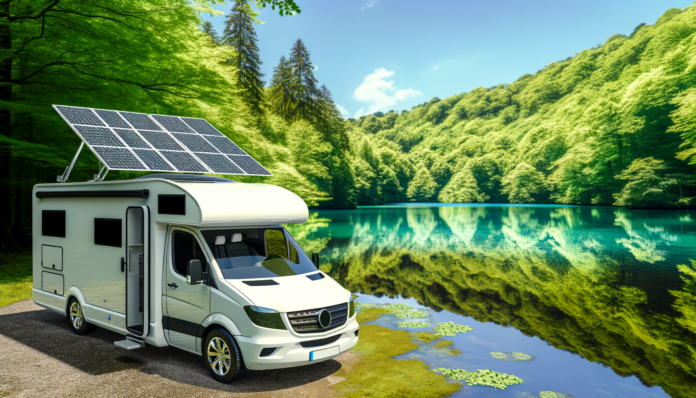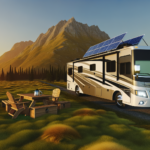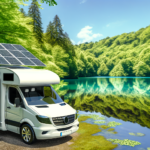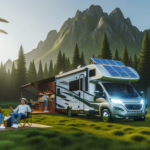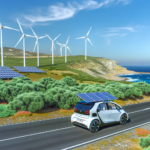Introduction to Solar Power for RVs
Why Choose Solar Power for Your RV?
When it comes to RV travel, having a reliable source of electricity is crucial. Traditionally, RVs have relied on batteries, generators, and external power supplies to meet their energy needs. However, solar power is rapidly becoming a popular choice among RV enthusiasts. But why should you consider solar power for your RV?
First and foremost, solar power is environmentally friendly. Unlike generators, which emit noise and fumes, solar panels operate silently and produce no emissions. This makes them an excellent choice for those who want to minimize their environmental footprint while enjoying the great outdoors.
Additionally, solar power offers unparalleled convenience. Once installed, solar panels require minimal maintenance and can provide a continuous power supply as long as the sun is shining. This means you can enjoy extended periods of off-grid travel without worrying about running out of power or finding a place to recharge your batteries.
Benefits of Solar Power for RV Travel
The benefits of integrating solar power into your RV are numerous and compelling:
- Energy Independence: With solar panels, you are no longer reliant on campground hookups or noisy generators. This allows you to camp in more remote locations and enjoy a greater sense of freedom.
- Cost Savings: While the initial investment in solar panels and related equipment can be significant, the long-term savings are substantial. You’ll save on fuel costs for generators and reduce or eliminate campground fees for electrical hookups.
- Quiet Operation: Solar panels operate silently, allowing you to enjoy the peace and tranquility of nature without the constant hum of a generator.
- Low Maintenance: Once installed, solar panels require very little maintenance. Occasional cleaning and periodic checks are usually all that’s needed to keep your system running efficiently.
- Environmental Impact: Solar power is a clean, renewable energy source. By using solar panels, you reduce your carbon footprint and contribute to a more sustainable future.
Understanding the Basics of Solar Energy
Before diving into the specifics of integrating solar power into your RV, it’s essential to understand the basics of how solar energy works.
Solar panels are made up of photovoltaic (PV) cells, which convert sunlight into electricity. When sunlight hits the PV cells, it excites electrons, creating an electric current. This current is then captured and converted into usable electricity.
The electricity generated by solar panels is direct current (DC) electricity. Most RV appliances and devices run on alternating current (AC) electricity, so an inverter is used to convert the DC electricity into AC electricity. This allows you to power standard household appliances and devices in your RV.
A typical RV solar power system consists of several key components:
- Solar Panels: These are installed on the roof of your RV and capture sunlight to generate electricity.
- Charge Controller: This device regulates the voltage and current coming from the solar panels to prevent overcharging the batteries.
- Batteries: The electricity generated by the solar panels is stored in batteries, which provide power when the sun isn’t shining.
- Inverter: This device converts the DC electricity stored in the batteries into AC electricity, which can be used to power your RV’s appliances and devices.
By understanding these basic components and how they work together, you’ll be better equipped to design and install a solar power system that meets your RV’s energy needs. Whether you’re a weekend warrior or a full-time RVer, solar power can provide a reliable, sustainable, and cost-effective solution for your energy needs on the road.
Assessing Your RV’s Energy Needs
Calculating Your Daily Energy Consumption
Understanding your RV’s energy needs begins with calculating your daily energy consumption. This involves identifying all the electrical devices and appliances you use and determining their power requirements. Here’s a step-by-step guide to help you get started:
1. **List Your Devices**: Make a comprehensive list of all the electrical devices and appliances you use in your RV, such as lights, refrigerator, microwave, TV, laptop, and air conditioner.
2. **Determine Wattage**: Find out the wattage of each device. This information is usually available on the device’s label or in the user manual.
3. **Estimate Usage Time**: Estimate the number of hours each device is used per day.
4. **Calculate Watt-Hours**: Multiply the wattage of each device by the number of hours it is used daily to get the watt-hours (Wh) consumed per day.
For example, if you have a 60W laptop that you use for 5 hours a day, it consumes 300Wh per day (60W x 5h = 300Wh). Repeat this process for all your devices and sum up the total watt-hours to get your daily energy consumption.
Identifying Essential vs. Non-Essential Power Needs
Once you have a clear picture of your daily energy consumption, the next step is to differentiate between essential and non-essential power needs. This distinction is crucial for optimizing your solar power system and ensuring you have enough energy for critical functions.
1. **Essential Power Needs**: These are the devices and appliances that are crucial for your daily living and safety. Examples include:
– **Refrigerator**: Keeps your food fresh and prevents spoilage.
– **Lights**: Essential for visibility and safety, especially at night.
– **Water Pump**: Necessary for accessing water for drinking, cooking, and cleaning.
– **Communication Devices**: Phones, radios, or any device that keeps you connected in case of emergencies.
2. **Non-Essential Power Needs**: These are the devices that enhance comfort and convenience but are not critical for survival. Examples include:
– **TV and Entertainment Systems**: Nice to have but not essential.
– **Microwave and Coffee Maker**: Useful but can be substituted with other cooking methods.
– **Air Conditioner**: Important for comfort, especially in hot climates, but can be a significant power drain.
By identifying and prioritizing your essential power needs, you can ensure that your solar power system is designed to meet your most critical energy requirements first.
Considering Seasonal and Geographic Variations
Seasonal and geographic variations can significantly impact your RV’s energy needs and the efficiency of your solar power system. Here are some factors to consider:
1. **Sunlight Availability**: The amount of sunlight you receive varies depending on your location and the time of year. For example, northern regions receive less sunlight in the winter compared to southern regions. Use solar insolation maps to estimate the average sunlight hours in your travel areas.
2. **Temperature Variations**: Extreme temperatures can affect both your energy consumption and the efficiency of your solar panels. In colder climates, you may need more energy for heating, while in hotter climates, air conditioning can be a significant power drain. Additionally, solar panels are generally more efficient in cooler temperatures.
3. **Travel Patterns**: Consider your typical travel patterns and destinations. If you frequently travel to areas with abundant sunlight, you can rely more on solar power. However, if you often visit shaded or cloudy regions, you may need to supplement your solar system with other power sources like a generator.
4. **Seasonal Adjustments**: Be prepared to adjust your energy usage and solar panel positioning based on the season. In the winter, you may need to tilt your panels to capture the lower-angle sunlight, while in the summer, you can lay them flat to maximize exposure.
By taking these seasonal and geographic variations into account, you can better plan and optimize your RV’s solar power system to ensure reliable energy supply throughout your travels.
Choosing the Right Solar Components
Types of Solar Panels: Monocrystalline vs. Polycrystalline
When selecting solar panels for your RV, you will primarily encounter two types: **monocrystalline** and **polycrystalline**.
**Monocrystalline panels** are made from a single continuous crystal structure. They are typically more efficient and have a higher power output per square foot, making them ideal for RVs where space is limited. These panels are also more durable and perform better in low-light conditions. However, they tend to be more expensive.
**Polycrystalline panels**, on the other hand, are made from multiple silicon crystals. They are generally less efficient and require more space to produce the same amount of power as monocrystalline panels. However, they are more affordable and can be a good option if you have ample roof space on your RV.
**Key Points to Consider:**
– **Efficiency**: Monocrystalline panels are more efficient.
– **Cost**: Polycrystalline panels are more affordable.
– **Space**: Monocrystalline panels are better for limited space.
Selecting the Right Charge Controller
A charge controller is essential for regulating the voltage and current coming from your solar panels to your batteries. There are two main types of charge controllers: **Pulse Width Modulation (PWM)** and **Maximum Power Point Tracking (MPPT)**.
**PWM controllers** are simpler and less expensive. They work by gradually reducing the amount of power going into your batteries as they get closer to full charge. While effective, they are less efficient than MPPT controllers.
**MPPT controllers** are more advanced and can be up to 30% more efficient than PWM controllers. They adjust the input voltage to find the maximum power point of the solar panels, ensuring that your batteries charge as efficiently as possible. Although more expensive, MPPT controllers are generally worth the investment for their efficiency gains.
**Key Points to Consider:**
– **Efficiency**: MPPT controllers are more efficient.
– **Cost**: PWM controllers are more affordable.
– **Battery Health**: Both types protect your batteries from overcharging.
Battery Options: Lead-Acid vs. Lithium-Ion
The choice of battery is crucial for storing the energy generated by your solar panels. The two main types of batteries used in RV solar systems are **lead-acid** and **lithium-ion**.
**Lead-acid batteries** are the traditional choice and come in two varieties: flooded and sealed (AGM or Gel). They are less expensive but heavier and have a shorter lifespan. They also require regular maintenance, especially the flooded type.
**Lithium-ion batteries** are more modern and offer several advantages. They are lighter, have a longer lifespan, and require no maintenance. They also have a higher depth of discharge, meaning you can use more of their capacity without damaging them. However, they are significantly more expensive upfront.
**Key Points to Consider:**
– **Weight**: Lithium-ion batteries are lighter.
– **Lifespan**: Lithium-ion batteries last longer.
– **Maintenance**: Lead-acid batteries require more maintenance.
– **Cost**: Lead-acid batteries are more affordable.
Inverters: Pure Sine Wave vs. Modified Sine Wave
An inverter is necessary to convert the DC power stored in your batteries into AC power, which is used by most household appliances. There are two main types of inverters: **pure sine wave** and **modified sine wave**.
**Pure sine wave inverters** produce a smooth, consistent wave of electricity, similar to what you get from the grid. They are ideal for sensitive electronics and appliances, ensuring they run efficiently and without risk of damage. However, they are more expensive.
**Modified sine wave inverters** produce a more choppy wave of electricity. They are less expensive and can power most basic appliances, but they may cause issues with sensitive electronics and are generally less efficient.
**Key Points to Consider:**
– **Compatibility**: Pure sine wave inverters are better for sensitive electronics.
– **Cost**: Modified sine wave inverters are more affordable.
– **Efficiency**: Pure sine wave inverters are more efficient.
By carefully selecting the right solar components for your RV, you can ensure a reliable and efficient solar power system that meets your energy needs and enhances your off-grid adventures.
Installation Process
Planning Your Solar Panel Layout
Before diving into the installation, it’s crucial to plan the layout of your solar panels. The roof of your RV is prime real estate, and you need to make the most of it. Start by measuring the available space and identifying any obstructions such as vents, air conditioners, or antennas.
Consider the following tips:
- Orientation: Ideally, solar panels should face south to maximize sun exposure. However, since RVs are mobile, this isn’t always possible. Aim to place panels where they will receive the most sunlight throughout the day.
- Spacing: Leave enough space between panels for airflow and maintenance. This helps in cooling and ensures optimal performance.
- Future Expansion: Plan for potential future additions. Leave some space for extra panels if you think you might need more power down the line.
Mounting Solar Panels on Your RV
Once you have a layout plan, the next step is mounting the panels. Here’s a step-by-step guide:
- Clean the Roof: Ensure the roof is clean and free of debris. This helps the adhesive and mounting brackets to stick better.
- Install Mounting Brackets: Attach the mounting brackets to the solar panels. Use stainless steel hardware to prevent rusting.
- Position the Panels: Place the panels on the roof according to your layout plan. Mark the positions for drilling.
- Drill Holes: Carefully drill holes for the mounting brackets. Be cautious to avoid damaging any underlying structures.
- Secure the Panels: Use screws and adhesive to secure the mounting brackets to the roof. Ensure they are tightly fastened to withstand wind and movement.
- Seal the Holes: Apply a generous amount of sealant around the screws and brackets to prevent water leaks.
Wiring and Connecting Your Solar System
With the panels mounted, the next step is wiring and connecting the system. This involves connecting the solar panels to the charge controller, batteries, and inverter.
- Run the Wires: Run the wires from the solar panels to the charge controller. Use a conduit to protect the wires and prevent wear and tear.
- Install the Charge Controller: Mount the charge controller inside the RV, close to the battery bank. This minimizes power loss.
- Connect to the Batteries: Connect the charge controller to the battery bank. Ensure you use the correct gauge wire to handle the current.
- Install the Inverter: If you plan to use AC appliances, install an inverter close to the battery bank. Connect the inverter to the batteries and run the necessary wiring to your AC outlets.
- Test the System: Before finalizing, test the entire system to ensure everything is working correctly. Check the voltage and current at various points to confirm proper connections.
Safety Tips and Best Practices
Safety is paramount when working with electrical systems. Here are some essential tips:
- Disconnect Power: Always disconnect the power before working on the electrical system to avoid shocks.
- Use Proper Tools: Use insulated tools and wear rubber-soled shoes to minimize the risk of electrical shock.
- Follow Manufacturer Guidelines: Adhere to the installation guidelines provided by the manufacturers of the solar panels, charge controller, and inverter.
- Check Polarity: Double-check the polarity of all connections. Incorrect polarity can damage the components.
- Fuse Protection: Install fuses or circuit breakers to protect the system from overcurrent situations.
- Regular Inspections: Periodically inspect the system for any signs of wear, corrosion, or loose connections.
By following these steps and safety tips, you can successfully install a solar power system in your RV, providing you with a reliable and sustainable energy source for your travels.
Maintenance and Troubleshooting
Routine Maintenance for Optimal Performance
To ensure your RV solar power system operates at peak efficiency, regular maintenance is essential. Here are some key tasks to keep your system in top shape:
- Clean the Solar Panels: Dust, dirt, and debris can accumulate on your solar panels, reducing their efficiency. Clean the panels with a soft cloth and mild detergent every few months or as needed.
- Inspect Wiring and Connections: Regularly check all wiring and connections for signs of wear, corrosion, or damage. Tighten any loose connections and replace any damaged wires immediately.
- Monitor Battery Health: Check the electrolyte levels in lead-acid batteries and top them up with distilled water if necessary. For lithium-ion batteries, ensure they are not exposed to extreme temperatures and monitor their charge cycles.
- Check the Charge Controller: Ensure the charge controller is functioning correctly by monitoring its display for any error messages or unusual readings. Clean the controller’s vents to prevent overheating.
- Test the Inverter: Periodically test the inverter to ensure it is converting DC to AC power efficiently. Listen for any unusual noises and check for overheating.
Common Issues and How to Fix Them
Even with regular maintenance, you may encounter some common issues with your RV solar power system. Here are a few problems and their solutions:
- Low Power Output: If your solar panels are not generating enough power, check for shading, dirt, or damage on the panels. Ensure all connections are secure and the charge controller is functioning correctly.
- Battery Not Charging: If your batteries are not charging, inspect the wiring between the solar panels, charge controller, and batteries. Check the charge controller settings and ensure it is compatible with your battery type.
- Inverter Not Working: If the inverter is not providing AC power, check the battery voltage to ensure it is within the inverter’s operating range. Inspect the inverter’s connections and reset it if necessary.
- Overheating Components: Overheating can be caused by poor ventilation or excessive load. Ensure all components have adequate airflow and reduce the load if necessary.
Seasonal Considerations for Solar Panels
The performance of your RV solar power system can vary with the seasons. Here are some tips to optimize your system year-round:
- Winter: In colder months, solar panels may produce less power due to shorter daylight hours and lower sun angles. Keep panels free of snow and ice, and consider using a tilt mount to angle the panels towards the sun.
- Summer: High temperatures can reduce the efficiency of solar panels and batteries. Ensure adequate ventilation for all components and consider using a solar panel cover to prevent overheating.
- Spring and Fall: These transitional seasons can bring variable weather conditions. Regularly check your system for any damage caused by storms or high winds and adjust the panel angle to capture the most sunlight.
By following these maintenance and troubleshooting tips, you can ensure your RV solar power system remains reliable and efficient, providing you with endless travel opportunities powered by the sun.
Maximizing Efficiency and Performance
Tips for Maximizing Solar Panel Efficiency
To get the most out of your RV solar power system, it’s crucial to maximize the efficiency of your solar panels. Here are some key tips:
- Optimal Placement: Ensure your solar panels are installed in a location that receives maximum sunlight throughout the day. South-facing panels generally capture the most sunlight.
- Regular Cleaning: Dust, dirt, and debris can significantly reduce the efficiency of your solar panels. Clean them regularly with soapy water or a glass cleaner to maintain optimal performance.
- Angle Adjustment: If possible, adjust the angle of your panels to match the sun’s position. This is especially important during different seasons when the sun’s angle changes.
- Shading: Avoid placing panels in areas where they might be shaded by trees, antennas, or other obstructions. Even partial shading can drastically reduce efficiency.
- Use High-Quality Components: Invest in high-efficiency monocrystalline panels and MPPT (Maximum Power Point Tracking) charge controllers to ensure you are capturing and utilizing the maximum amount of solar energy.
Energy-Saving Practices for RV Living
Maximizing the efficiency of your solar power system also involves adopting energy-saving practices. Here are some strategies to consider:
- LED Lighting: Replace incandescent bulbs with LED lights, which consume significantly less power and have a longer lifespan.
- Energy-Efficient Appliances: Use energy-efficient appliances and devices. Look for those with high Energy Star ratings.
- Unplug Devices: Unplug devices and appliances when not in use to prevent phantom loads, which can drain your battery.
- Smart Usage: Run high-energy appliances like microwaves and air conditioners during peak sunlight hours when your solar panels are generating the most power.
- Insulation: Improve your RV’s insulation to reduce the need for heating and cooling, thereby saving energy.
Using Solar Power in Conjunction with Other Energy Sources
While solar power can significantly reduce your reliance on traditional energy sources, combining it with other energy solutions can provide a more robust and reliable power system. Here are some options:
- Generator: A portable generator can serve as a backup power source for cloudy days or when your energy consumption exceeds what your solar panels can provide.
- Wind Turbine: Consider installing a small wind turbine to complement your solar power system. Wind energy can be particularly useful in areas with consistent wind patterns.
- Shore Power: When available, connect to shore power to recharge your batteries and run high-energy appliances without draining your solar power reserves.
- Hybrid Systems: Some RVers opt for hybrid systems that combine solar, wind, and generator power to ensure a steady and reliable energy supply.
By following these tips and integrating multiple energy sources, you can maximize the efficiency and performance of your RV solar power system, ensuring a sustainable and enjoyable off-grid experience.
Conclusion and Additional Resources
Recap of Key Points
As we conclude this ultimate guide to integrating solar power in your RV, let’s recap the key points covered:
- Introduction to Solar Power for RVs: We explored why solar power is an excellent choice for RVs, highlighting its benefits such as cost savings, environmental impact, and independence from traditional power sources.
- Assessing Your RV’s Energy Needs: We discussed how to calculate your daily energy consumption, differentiate between essential and non-essential power needs, and consider seasonal and geographic variations.
- Choosing the Right Solar Components: We examined the different types of solar panels, charge controllers, batteries, and inverters to help you make informed decisions.
- Installation Process: We provided a step-by-step guide on planning your solar panel layout, mounting the panels, wiring the system, and ensuring safety.
- Maintenance and Troubleshooting: We covered routine maintenance practices, common issues and their fixes, and seasonal considerations for optimal performance.
- Maximizing Efficiency and Performance: We offered tips for maximizing solar panel efficiency, energy-saving practices for RV living, and using solar power in conjunction with other energy sources.
Additional Resources and Further Reading
To further enhance your knowledge and ensure a successful solar power integration in your RV, consider exploring the following resources:
- Homeowner’s Guide to Solar by the U.S. Department of Energy
- Solar Power World for the latest news and trends in solar technology
- RV Travel for tips and advice on RV living and maintenance
- Solar Reviews for reviews and comparisons of solar products
- RV Geeks YouTube Channel for practical video tutorials on RV solar installations
Encouragement for Sustainable RV Living
Embracing solar power for your RV is not just a smart financial decision; it’s a commitment to sustainable living. By harnessing the sun’s energy, you reduce your carbon footprint and contribute to a cleaner, greener planet. The freedom and independence that come with solar power allow you to explore remote locations without worrying about power sources, making your travels more enjoyable and eco-friendly.
Remember, every small step towards sustainability counts. Whether you’re a seasoned RVer or just starting, integrating solar power into your RV is a significant move towards a more sustainable lifestyle. So, take the plunge, invest in solar technology, and enjoy endless travel with the peace of mind that comes from knowing you’re making a positive impact on the environment.
Happy travels and sunny adventures!


